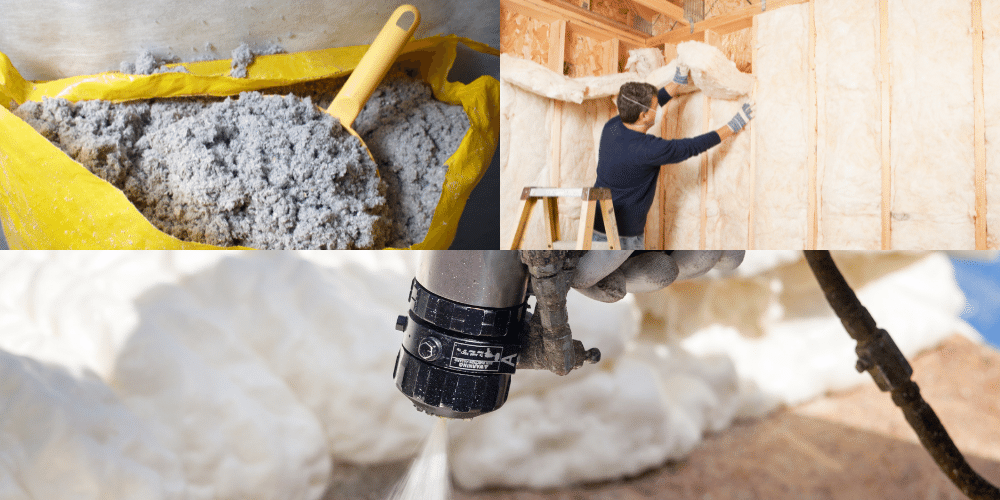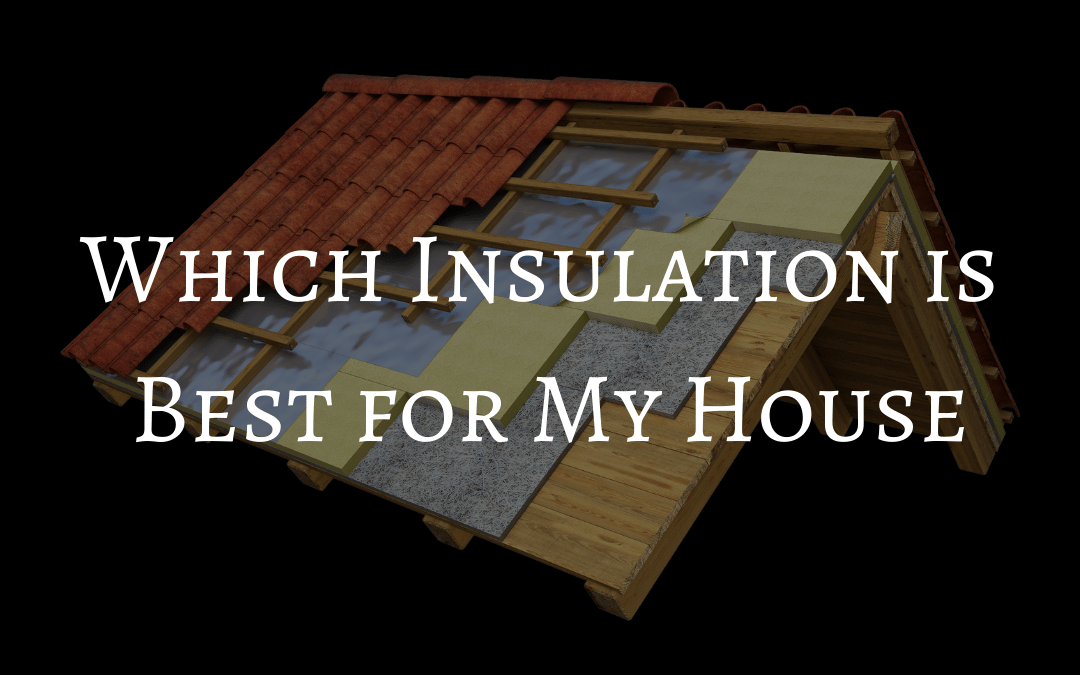You know your home needs insulation; the hard decision is: do you use spray foam, injection foam, fiberglass, or cellulose?
Why is insulation so crucial in your home?
Insulation in your home keeps the air you pay to heat or cool inside and Mother Nature outside. As long as there are no air leaks, insulation can help prevent your furnace and air conditioner from overworking.
You also want your insulation to seal your home’s construction envelope. Your living space is separated from the outdoors by your building envelope. You will need to research the properties of different insulation materials to create the necessary air seal for the building envelope.
It can be difficult to choose the right home insulation. You need to consider the cost, effectiveness, and whether it will save you money over the long term.
Let’s look at which types of insulation are best and how they work for each room.
Best Insulation Material: Cellulose vs Fiberglass vs Foam
Let’s take a closer glance at these house insulation comparisons to understand better what we are doing.
Spray foam is rated higher than cellulose and fiberglass because it creates an air sealing system that is impossible with cellulose or fiberglass. This air seal allows for energy savings. In addition, your furnace and air conditioner will not have to work overtime to maintain constant temperatures.
House Insulation Comparison

Does a higher R-Value indicate that it is the best insulation for your home? Again, it all boils down to the value versus creating an air sealing system.
- Closed Cell Spray Insulation Foam R-Value: R-6 to R-7
- Foam Board Insulation R-Value x: R-4.5 to R-5
- RetroFoam Injection Insulation R-Value: R-4.6 to R-5
- Open Cell Spray Foam Insulation R-Value: R-3.6 to R-3.9
- Cellulose (Loose-Fill) Insulation R-Value: R-3.1 to R-3.8
- Fiberglass (Batts) Insulation R-Value: R-2.9 to R3.8
- Fiberglass (Loose-Fill) Insulation R-Value: R-2.2 to R-2.9
Although you might reach the R-Value that you desire, if it does not create an air seal, then there is still air movement. This can affect the comfort and energy efficiency in your home.
Safety is an important aspect of any insulation you use in your home. There are three options for insulation that are Class 1 Fire Rated. This means that insulation with this rating won’t act as a catalyst in the event of a fire at your home.
Let’s talk about maintenance and cost. The chart shows that fiberglass is the most affordable, while cellulose and spray foam is the most expensive. Maintenance is important to discuss when discussing cost. Fiberglass and cellulose both need to be maintained over time. Spray foam, on the other hand, is one-time and doesn’t require any maintenance.
Let’s now look at your house from the top. Now let’s go to the bottom.
Best Attic Insulation: Spray Foam vs Cellulose vs Fiberglass
Attic insulation is a great way to reduce the amount of money that pours through your roof.
When your attic is in need of new or updated insulation, you will notice high energy bills and an inability to maintain constant temperatures. Open cell spray foam, fiberglass and cellulose are the best options for home attic insulation.
Cellulose insulation is one of the most common materials used in the attic. Cellulose is available in loose-fill and blown-in forms. It is mostly made from recycled newsprint and denim.
Cellulose is a simple and inexpensive insulation material. However, cellulose can also settle to up to 20%, shift to one side, and doesn’t form an air seal. This allows cold and hot air to flow freely through the attic, increasing monthly energy bills.
Fiberglass, another traditional insulation material, is made up of very fine glass fibers.
Fiberglass is easy to install and very affordable. Fiberglass can be inhaled or embedded in the skin. It still allows airflow to the attic.
Open cell foam creates an air barrier that prevents air movement. It expands up to 100x its original size, filling every corner of the attic. It is made from water-blown organic chemical compounds and petroleum extracts.
Spray foam has a Class One Fire Rating, so it will not act as a catalyst in the event of a fire. It doesn’t retain water that could encourage mold and mildew. Additionally, it creates an Air Seal that helps lower monthly energy bills and creates semi-conditioned spaces by insulating the roof deck of an unvented loft.
Spray foam has a downside. It is more costly than traditional insulation. Also, it is too complicated to do yourself. A contractor must install it.
Best Insulation for Existing Walls: Blown-In Cellulose vs Injection Foam

When it comes to your walls, there is no way to know. However, an experienced contractor must install the insulation.
You can add insulation to existing walls without removing your drywall or incurring the additional cost of a complete remodel.
Similar methods can be used to install blown-in cellulose in existing walls. The first step is to remove the siding. Next, drill a hole in each cavity. Once the cavity is full, inject or blow in the material. Finally, plug the hole and replace the siding.
Insulation does its job by affecting conduction, heat transfer, and convection. This can impact your home’s comfort and energy efficiency.
Traditional insulation
Traditional house insulation, such as cellulose, is resistant to heat transfer by conduction. In the winter, heat is transferred from your home to the outside.
Airflow is the movement of air through holes in walls or electrical outlets. This is a major source of energy loss in your home. This can also cause discomforts in your home, such as drafts and cold floors.
Foam insulation is the best choice to reduce air leakage because it offers heat resistance and an air seal.
A second problem you may notice is air leakage or insufficient insulation in your walls. This can lead to condensation and moisture in the walls, which can cause mold and mildew growth.
Best Crawl Space Insulation: Spray Foam vs Fiberglass

When discussing the best insulation materials for crawl spaces, the discussion is usually about fiberglass vs foam.
Insulate the crawl space walls with non-water-sensitive insulation to keep the interior air from reaching the cold surfaces. According to the Building Science Corporation, allowing moisture-laden interior air to condense can lead to condensation and mold growth.
A crawl area can be an area with more moisture than other areas of your current home.
However, fiberglass is not a good choice for this area. The fiberglass’s properties are greatly reduced when it gets wet. If you want your insulation down there to function, you will need to replace it.
Spray foam is the best option because it doesn’t retain water and creates air sealing. Fiberglass is cheaper and can be installed yourself. However, spray foam will create the air seal that you desire in your space.
Because of this, the Building Science Corporation recommends using foam-based insulation materials for crawl spaces.
Best Rim Joist Insulation: Fiberglass vs Foam

The rim joist in your home is often overlooked if you want to find the culprit for drafts around the floorboards.
The best options available for the rim joint are spray foam and fiberglass.
Fiberglass is affordable and easy to install, but it doesn’t do as well at insulating the perimeter joist as fiberglass. Fiberglass can also cause mold problems when installed in the rim joint. It holds condensation against wood which can lead to decay and mold.
Spray foam does not retain water, so it isn’t as moist as fiberglass. In addition, spray foam will create an air seal, which prevents outside air from entering and reduces drafts around the floorboard.
Fine Home Building recommends using only air-impermeable insulation in the rim joint – either spray foam or rigid foam boards.
How to Choose the Best Insulation Material For Your Home
You have the final say in choosing the right insulation material for your home.
You will need to consider the pros and cons of the materials, your goals, and your budget to determine the best option for you.
Foam products are the best option to make your home more comfortable and save money on your monthly energy bill. Foam insulation is highly durable and fills every nook and crevice where it’s installed. While traditional insulation is a cheaper option that can be done yourself.


